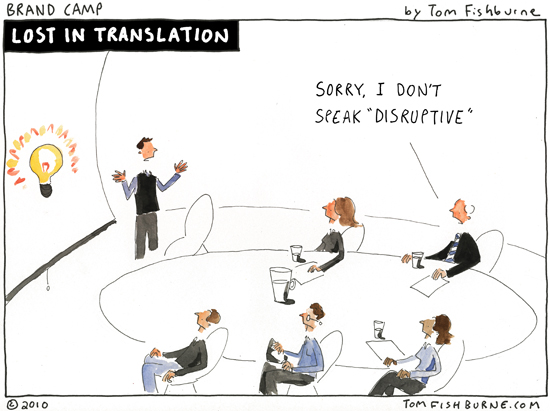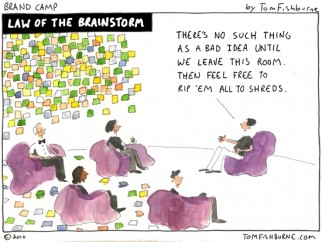I had a “Lost in Translation” moment a couple weeks ago in a meeting with 20 French and Russian executives. It was the first time I’d ever been in a meeting where someone simultaneously translated the discussion into ear pieces. I spent the whole meeting wondering if they really understood what we were trying to communicate. Many of my jokes fell flat and their questions back (through the same translator) seemed like non-sequiturs.
This language gap made me think of the cultural gap that exists in business, particularly around innovation. We may all speak English in business life, but that doesn’t mean that we speak the same language. Innovation that challenges the status quo is particularly foreign.
I once took a class with Clayten Christensen, who wrote The Innovator’s Dilemma and coined the term disruptive innovation. He described that businesses typically ignore disruptive innovations. Even if they recognize a disruptive innovation, they are reluctant to take advantage of it, because it threatens their existing business. Often they wait to take action until it is too late.
While taking this class, my bike route took me past the Polaroid headquarters in Cambridge. They were a classic case of a business that ignored a disruptive innovation in digital photography. As if to prove Christensen’s point, Polaroid filed for Chapter 11 bankruptcy protection midway through the class. Failing to acknowledge a disruptive innovation ultimately led to the demise of the company.
When trying to advance any form of innovation that challenges the status quo, we have to recognize the cultural intertia that will block those types of projects. Without overcoming the translation gap, those ideas will never get off the ground.



Ted Simon says
Good observations, Tom.
Polaroid’s a great example; it was like they got hit by a train. Come to think of it, that’s a whole INDUSTRY that hid its head in the sand from disruptive innovation. 🙂
Cheers,
ted
Euonymous says
We all saw that train heading toward Polaroid. A business school case study from maybe 20+ years ago indicated that Polaroid’s early success was in part attributable to magazines and newspapers not allowing them to advertise because of their early financial situation. TV, however, did take early Polaroid ads, and the rest is history. Sometimes fate works in your favor. Nothing forced Polaroid to go digital until way too late.
With respect to translations, you may enjoy this: At a science fiction convention in Metz, France years ago the guest of honor was Robert Bloch (who wrote Psycho). He only spoke English. The assembled group spoke English, French, or both. He told some very funny stories. One of which was about seeing the original “THE FLY” with Vincent Price and at a key point in the movie paying the ultimate complement that a 10 year old boy could pay to a horror movie: he wet his pants. Everyone who understood the story in English roared with laughter. Then came the French translation. Another roar of laughter. Then another uprising roar of laughter as the group responded to the dynamics of the translation. Best bilingual experience ever!
Patrick_joiner says
It’s easy to look back on digital photography as a disruptive technology now; I can still remember my digital camera in the mid to late 1990s that was maybe 640×480 pixels and looked terrible compared to film. At that time the convenience of digital photography didn’t outweigh the fact that the photos were difficult to distribute to people and prints looked very jagged. Not to mention the fact that flash memory was not so cheap back then.
I think it was only after the advent of megapixel cameras, cheap flash memory, AND the infrastructure for printing (including sites such as Shutterfly as well as lower cost color printers) that what seemed like a novelty became a real threat. The speed at which these changes happened finished off Polaroid and almost Kodak as well.
Polaroid has come back though with the Pogo (http://www.polaroid.com/Products/Polaroid+PoGo/Overview/Overview/1804); now the disrupted has become the disruptor. If they had come up with the Pogo in the 90’s they would be in a much better position now. We’ll see if this catches on.
Rick Mueller says
Pogo’s only uniqueness is in the product itself – consisting of a built-in printer which uses proprietary paper to make small (photo size) color prints on demand in a very compact frame.
Success in Disruptive Innovation (per Christensen) also requires an avoidance of head to head combat with current industry incumbents.
By targeting existing customers of that industry, Polaroid is placing itself at great risk and is missing an enormous opportunity to gain the traction it will need to regain dominance in its industry.
Consider what might result if Polaroid were to apply this technology to print photos, screen shots, documents, and other files from smartphones instead. THAT would have the potential to become a GENUINELY disruptive innovation.
From the perspective of disruptive innovation, the current strategy (going head to head with existing incumbents in the digital photo industry) is just plain stupid and has little if any opportunity to even become successful, much less disruptive.
Rick @
http://www.linkedin.com/in/decisionscience